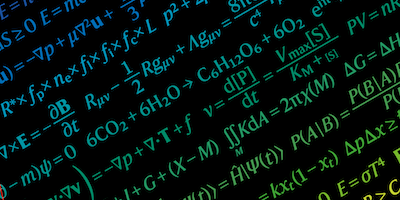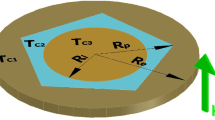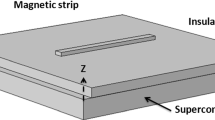Abstract
Recent progress in nanotechnology has stimulated interest in mesoscopic superconductors as components for quantum computing and cryoelectronics. The critical parameters for superconductivity (current and field) of a mesoscopic sample are determined by the pattern of vortices in it, which in turn is controlled by the symmetry imposed by the shape of the sample (see ref. 1 and references therein). Hitherto it has been unclear what happens when the number of vortices is not consistent with the natural symmetry. Here we show that additional vortex–antivortex pairs nucleate spontaneously so as to preserve the symmetry of the sample. For example, in a square with three vortices, the spontaneously generated pair, along with the original three vortices, distribute themselves so that the four vortices sit in the four corners, with the antivortex in the centre. The measured superconducting phase boundary (of superconducting transition temperature Tc versus magnetic field strength) is in very good agreement with the calculations, giving direct experimental evidence for these symmetry-induced vortex–antivortex pairs. Vortex entry into the sample is also changed: vortices enter a square in fours, with antivortices generated to preserve the imposed vorticity. The symmetry-induced nucleation of antivortices is not restricted to superconductors, but should also apply to symmetrically confined superfluids and Bose–Einstein condensates.





Similar content being viewed by others
References
Moshchalkov, V. V. et al. in Handbook of Nanostructured Materials and Nanotechnology (ed. Nalwa, H. S.) Vol. 3, Ch. 9, 451– 525 (Academic, San Diego, 1999).
de Gennes, P.-G. Superconductivity of Metals and Alloys (Benjamin, New York, 1966).
Saint-James, D. & de Gennes, P.-G. Onset of superconductivity in decreasing fields. Phys. Lett. 7, 306–308 (1963).
Landau, L. D. & Lifshitz, E M. Quantum Mechanics 2nd edn (Pergamon, Oxford, 1975).
Bruyndoncx, V., Strunk, C., Moshchalkov, V. V., Van Haesendonck, C. & Bruynseraede, Y. Fluxoid quantization effects in superconducting mesoscopic Al multiloop structures. Europhys. Lett. 36, 449–454 (1996).
Saint-James, D. Etude du champ critique Hc3 dans une géometrie cylindrique. Phys. Lett. 15, 13–15 (1965).
Abrikosov, A. A. Fundamentals of the Theory of Metals (North-Holland, Amsterdam, 1988).
Chang, A. M. et al. Scanning Hall probe microscopy. Appl. Phys. Lett. 61, 1974–1976 ( 1992).
Oral, A., Bending, S. J. & Henini, M. Real-time scanning Hall probe microscopy. Appl. Phys. Lett. 69, 1324–1326 (1996).
Hess, H. F., Robinson, R. B., Dynes, R. C., Valles, J. M. Jr & Waszcak, J. V. Scanning-tunneling-microscope observation of the Abrikosov flux lattice and the density of states near and inside a fluxoid. Phys. Rev. Lett. 62, 214 –216 (1989).
Maggio-Aprile, I., Renner, Ch., Erb, A., Walker, E. & Fischer, O. Direct vortex lattice imaging and tunneling spectroscopy of flux lines on YBa2Cu3O7-δ. Phys. Rev. Lett. 75, 2754–2757 (1995).
Moser, A. et al. Observation of single vortices condensed into a vortex-glass phase by magnetic force microscopy. Phys. Rev. Lett. 74, 1847–1850 (1995).
Harada, K. et al. Direct observation of vortex dynamics in superconducting films with regular arrays of defects. Science 274, 1167–1169 (1996).
Li, W.-K. & Blinder, S. M. Solution of the Schrödinger equation for a particle in an equilateral triangle. J. Math. Phys. 26, 2784–2786 ( 1985).
Acknowledgements
The work was supported by the ESF programme VORTEX, Concerted Action Scheme (GOA) of the Flemish Government and by the Fonds voor Wetenschappelijk Onderzoek Vlaanderen (FWO). We would like to thank L. Van Look for taking the atomic force microscope micrograph.
Author information
Authors and Affiliations
Corresponding author
Rights and permissions
About this article
Cite this article
Chibotaru, L., Ceulemans, A., Bruyndoncx, V. et al. Symmetry-induced formation of antivortices in mesoscopic superconductors . Nature 408, 833–835 (2000). https://doi.org/10.1038/35048521
Issue Date:
DOI: https://doi.org/10.1038/35048521
- Springer Nature Limited
This article is cited by
-
Creating polar antivortex in PbTiO3/SrTiO3 superlattice
Nature Communications (2021)
-
Vortex Configurations of a Nano-sized Superconducting 3D Pyramidal Confinement
Journal of Superconductivity and Novel Magnetism (2020)
-
Vortex States in a Multigeometric Mesoscopic Superconductor
Journal of Low Temperature Physics (2020)
-
Magnetic-Field-Induced Vortices and Antivortices in a Mesoscopic Ferromagnet/Insulator/Superconductor Strip
Journal of Low Temperature Physics (2019)
-
The Influence of Pinning Centers in the Magnetization of the Mesoscopic Superconductors
Journal of Superconductivity and Novel Magnetism (2018)





